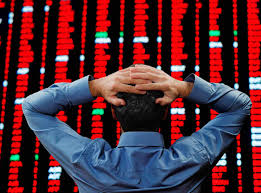October 19, 2017 marks the 30th anniversary of the worst single day stock market decline in history, an unprecedented event saw the S&P 500 stock index fall by 23% and sent a shock wave which roiled international financial markets for two years.
Yet despite the severity, traders and researchers have never agreed on a single reason for this statistically improbable event which one academic* estimated would only occur once in 20 billion years.
In October 1987, I was the marketing director for the now-defunct New York Futures Exchange (a division of the NYSE), which listed more stock index futures contracts (the Russell 2000, Russell 300, and NYSE Composite Index futures) than other U.S. exchanges. Even though S&P 500 Index futures trading on the Chicago Mercantile Exchange (where I also worked earlier) was by far the most liquid and essential, the NYFE offered additional liquidity and many arbitrage opportunities to stock index futures traders.
The 1987 crash was unprecedented in many ways: its use of technology, financial engineering, new strategies, limited regulation, a “greed is good” mentality, leverage, and global impact.
And as a substantial financial event, what caused it is still a mystery 30 years after the event.
Yet, while the majority of financial market commentators who note this anniversary will focus on statistics, the benefits of portfolio diversification, and new causes of market volatility, few will remember the Crash for what it was: a landmark political battle about the limitations of the New York Stock Exchange’s specialist system versus the role of stock index futures and electronic trading. The thrust of this battle was about preserving the traditional trading system, while avoiding discussions about the structural deficiencies which constricted trading liquidity.
This battle involved the financial industry’s most prominent players. The subsequent debate brought many of Wall Street’s biggest names into a rare public discussion: pension fund managers, white shoe trading department directors, major speculators, and mutual fund company presidents.
What drew these people into the light was years of pent-up frustrations about the NYSE’s specialist system. Except for commodity traders, no other profession in the financial business has been the target of so much criticism. Finance Professor Hans Stoll has noted that specialists have been criticized in every major study of the stock exchange system since 1935.
After the Crash, Congressional and independent investigators produced no less than 77 separate studies, some chaired by Wall Street’s most prominent names, to find the Crash’s culprits, causes and remedies. They came up empty-handed.
Among the most frequently cited criticisms have been conflicts of interest and costs. Specialists were pained as being able to equally serve upstairs traders, individuals, institutions and themselves. As the marketplace became more intertwined and complex, the specialists had difficulty sorting out their customers and their various trading demands. The first trading group to take their business away from the NYSE floor were index fund managers who went upstairs to cross portfolios at a lower cost without suffering from market impact.*
Overcoming the Bottleneck
By 1987, institutional traders openly considered the system a trading bottleneck that could not handle the popular stock index arbitrage strategies, rising volumes, and electronic executions. According to NYSE statistics, average daily volume in 1987 reached a record 190 million shares, up 34% from the previous peak of 141 million shares traded daily in 1986. This was five years after stock index futures began trading and about four years after the first stock index arbitrage program entered the NYSE’s Designated Order Turnaround (DOT) electronic order routing system. At its peak in 1987, program trading accounted for 10% of the total NYSE trading volume. 
For years, the NYSE worked to curtail electronic trading and accommodate futures-based equity strategies, which would have required changes in its floor trader specialist system. Until the Crash, this was a power struggle that occurred daily in regulatory trench warfare. The Crash forced this brawl into the street.
After the Crash, Congressional and independent investigators produced no less than 77 separate studies, some chaired by Wall Street’s most prominent names, to find the culprits, causes and remedies. One major battle boiled down to the NYSE versus the Chicago Mercantile Exchange which trades the index futures used in stock arbitrage. Each exchange activated its army of politicians, regulatory agencies, attorneys, consultants, and public relations machines to make their respective cases.
The best summary of the resulting thousands of pages of investigations came from the chief investment officer of the nation’s largest index fund, who said that the NYSE specialists “ran out of money, guts, and the willingness to compete” when they saw the cascading numbers. Within hours, this officer knew exactly which SIAC computers failed under the strain and how many of his orders never made it to the floor. Later, I asked an NYSE specialist, who the exchange says is the trader of last resort in market declines, why he did not start buying during that day. He looked me in the eye and said: “Son, down here we know never to try and kiss a speeding locomotive.”
The specialist made this comment at a time when two-thirds of his income came from floor brokerage commissions and the rest from trading. But he also worked in an environment with falling commissions. Today, that specialist’s income ratio is reversed, plus they are trading in an increasingly competitive environment accompanied by reduced trading spreads.
What the 1987 Crash Produced
Twenty years later, the Crash can be credited with the following: It accelerated the use of electronic trading for all investors, including the Small Order Execution System (SOES), for retail individuals to access the NASDAQ system.
The NYSE also realized it must upgrade and open its electronic trading capabilities to accommodate new strategies and products. Altered trading conditions and increased competition forced the exchanges to ventilate their systems, and as member incomes declined, going public emerged as the best way to cash out of these very valuable semi-public franchises. Today, the key players in the 1987 Crash–the NYSE, CME and CBOT–are all public companies.
The Crash also showed the irony of innovation. The venerable NYSE went public in a reverse IPO in a consortium led by a Chicago-based company, which started out as a SOES trading parlor. As a public company, the NYSE now is looking to expand by using shareholder money to buy futures and options exchanges. But as Yogi Berra said, “It’s déjà vu all over again” since the NYSE owned both types of derivatives exchanges in 1987 but let them wither and die for reasons its historians should answer.
Institutional and individual investors have benefited from the 1987 Crash. It broke the trading logjam on Wall Street, made exchanges more transparent, democratized an assortment of new, lower-cost products and strategies for retail investors, and accelerated the growth of anonymous electronic trading.
But all this took about two decades to accomplish. Which leaves us with the Crash’s most important message: Wall Street observers and the media commonly say the dominant force on Wall Street is greed. This is incorrect. It is inertia. Tradition commonly trumps innovation in the financial services industry. And while some antiquated practices remain, the Crash illuminated and eliminated some of Wall Street’s oldest and more arcane self-interest practices. What has not changed is the fact that time remains the friend of some and the enemy of others.
* Mark Rubinstein, Professor of Applied Investment Analysis at the University of California at Berkeley
** “The Big Board’s Blues: How Competition is Draining Liquidity from the New York Stock Exchange,” Global Custodian, December 1990.











